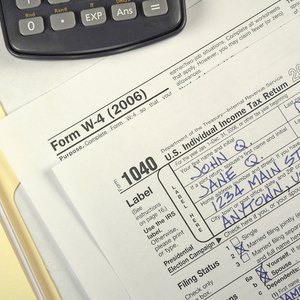
Filling out your W-4 correctly is one of the most important things you can do in regards to your taxes. Your W-4, a form your employer has you complete when you start a new job, determines how much in tax withholding to deduct from every paycheck. If you file this form incorrectly, you could have too little or too much tax withheld. Update this form whenever your life situation changes, such having a child or getting married, to prevent filing a return with the wrong status or with other errors. While you can withhold an additional flat amount on your W-4, you are still responsible for mandatory payroll taxes.
Tips
You can use Box 6 on your W-4 to tell your employer exactly how much tax you would like withheld from your regular paycheck.
What Does My W-4 Determine?
Many taxpayers are familiar with a W-4, at least on the surface. They recall completing it at the start of new employment, but might not go back to review or update it afterwards. Neither the IRS nor your employer will let you know when you should update your W-4.
Your IRS Form W-4, or "Employee’s Withholding Allowance Certificate," indicates to your employer how many allowances you wish to claim. These allowances in turn affect how much will be withheld from your paycheck for mandatory payroll deductions, including federal, state and local taxes, as well as Social Security and Medicare contributions.
You are allowed one allowance for yourself, one for each qualifying dependent and one allowance for your spouse. You can also claim allowances if you intend to itemize, or if you are planning to claim certain tax credits. Each allowance you claim increases the amount of take-home pay you receive. Claiming more allowances also increases your chance of receiving a tax bill come tax time. Sometimes, you may want to have more withheld from your taxes, such as when you’re anticipating owing taxes at the end of year, or if you want to increase the likelihood of a refund. In this case, you would decrease the number of allowances you claim.
Filling out Your W-4 Correctly
Form W-4 isn’t difficult to fill out, and its attached Personal Allowances Worksheet walks you through the number of allowances you can claim. Detach this worksheet from your W-4 before you submit it to your employer, and keep it for your records so you can refer to it later if you need to update it.
As you work through Lines A-F of the Personal Allowances Worksheet, enter either a “1” or “0” next to each line that is applicable to your situation. Enter information for Line G if you are planning to claim the Child Tax Credit. Next, total all Lines (A-G), and enter this number on Line H. The figure you reach on Line H is the total number of allowances you are able to claim. However, just because you are eligible to take a large number of allowances, doesn’t mean you necessarily should, as this could lead to a hefty tax bill if you aren't careful.
Now that you have the total number of allowances you can claim, you are ready to fill out the bottom portion of your Form W-4. In Boxes 1-3 enter your personal information, and only enter a check in Box 4 if your last name differs from the name on your Social Security card. In that case, follow the instructions provided in Box 4. Use Box 5 to enter the number of allowances you want to claim. Use either the figure from Box H, or any number less than that as the number of allowances you intend to claim.
To have a flat amount withheld from your taxes, use Box 6. Here, you can indicate the amount of additional money to withhold from every paycheck. This amount is independent of what you will pay in state, local or federal taxes. If you would like to have $500 withheld from every paycheck to cover an anticipated tax obligation, enter this amount here. Note that this amount will be withheld from every paycheck until you submit a new W-4. Lastly, complete and sign the form and submit it to your employer.
References
Writer Bio
Tara Thomas is a Los Angeles-based writer and avid world traveler. Her articles appear in various online publications, including Sapling, PocketSense, Zacks, Livestrong, Modern Mom and SF Gate. Thomas has a Bachelor of Science in marine biology from California State University, Long Beach and spent 10 years as a mortgage consultant.

